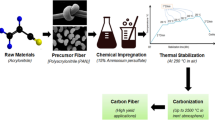Abstract
The kinetics of the thermal stabilization of triple polyacrylonitrile (PAN) fiber with respect to density, and the density distribution over the volume of PAN fiber the transition processes according to the analysis of crushed fiber samples in a gradient column and its effect on the manufacturability of PAN-fiber treatment are studied. It is established that the heterogeneity of the process leads to the formation of a granular nanostructure, whose grain size which largely determines the imperfection of the structure of the oxidized PAN fiber depends on the content of impurities in the PAN fiber. It is shown that imperfection at the current content of impurities can be reduced to the minimum possible level by increasing the rate of nucleation by raising the temperature to the maximum possible value under conditions of the exothermic effect, which leads to an increase in the number of grains and a decrease in their size. An algorithm and a control system are proposed, which allow one to carry out the process at the highest possible temperature without reaching the thermal-decomposition region by controlling the temperature-drop gradient in a thermal stabilization furnace.












Similar content being viewed by others
REFERENCES
A. I. Gusev, Nanomaterials, Nanostructures, Nanotechnologies (Fizmatlit, Moscow, 2005) [in Russian].
B. Delmon, Introduction a la cinetique heterogene (Ed. Technip, Paris, 1970).
P. Barret, Cinétique hétérogène (Gauthier-Villars, Paris, 1973).
E. M. Kartashov, B. Tsoi, and V. V. Shevelev, Structural-Statistical Kinetics of Polymer Degradation (Khimiya, Moscow, 2002) [in Russian].
G. M. Bartenev and Yu. S. Zuev, Strength and Fracture of Highly Elastic Polymers (Khimiya, Moscow, 1964) [in Russian].
I. I. Ryskina, V. P. Biryukov, et al., Khim. Volokna, No. 3, 14 (1993).
V. P. Biryukov, “Optimization of the thermal stabilization process in the production of carbon fiber based on PAN,” Extended Abstract of Doctoral (Tech. Sci.) Dissertation (NIIGrafit, Moscow, 2002).
A. V. Biryukov and V. P. Biryukov, in Proceedings of the International Conference on Chemical Fibers-2000, Tver’, 2000, p. 135.
E. T. Denisov, Oxidation and Degradation of Carbon Chain Polymers (Khimiya, Leningrad, 1990) [in Russian].
O. Levenshpil’, Engineering Design of Chemical Processes (Khimiya, Moscow, 1969) [in Russian].
V. P. Biryukov and A. S. Murina, in Proceedings of the 8th Annual Conference on Composite Materials: Production, Application, Market Trends, Moscow, Russia, November 26, 2014 (Soyuzkompozit, Moscow, 2014), p. 20.
V. Birukov, A. Murina, and S. Murin, Mater. Today: Proc., No. 5, 26160 (2018). https://doi.org/10.1016/j.matpr.2018.08.047
V. P. Biryukov, Mathematical Modeling and Optimization of Thermal Stabilization of Polyacrylonitrile Fiber (SGTU, Saratov, 2002) [in Russian].
V. Birukov and V. Mostovoy, Proc. Comp. Sci. 169, 578 (2020). https://doi.org/10.1016/j.procs.2020.02.207
V. P. Biryukov and A. M. Plotnikov, “Method for producing carbon fiber,” RF Patent (1999).
Author information
Authors and Affiliations
Corresponding author
Ethics declarations
The author declares that he has no conflicts of interest.
Additional information
Translated by O. Kadkin
Rights and permissions
About this article
Cite this article
Biryukov, V.P. Reducing the Influence of Inorganic Impurities on the Nanostructure of Oxidized Polyacrylonitrile Fiber in Carbon-Fiber Production by Control Methods. Nanotechnol Russia 17, 585–592 (2022). https://doi.org/10.1134/S2635167622040048
Received:
Revised:
Accepted:
Published:
Issue Date:
DOI: https://doi.org/10.1134/S2635167622040048



